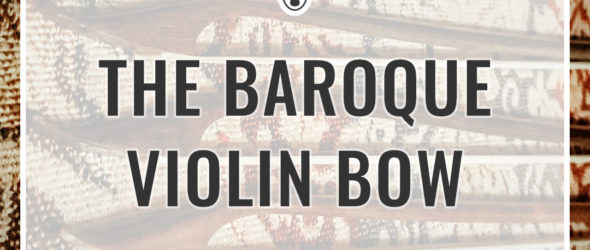Learn about the Baroque bow, how it was played, and its transition to the modern violin bow!
The Baroque era had its own distinctive Baroque bow, which had a different shape than the modern bow and gave different possibilities to the player. The Baroque violin bow came during one of the greatest periods of evolution for the violin, sometimes called “the golden era.” However, there was no such thing as a ‘standard’ bow as it originally came in a variety of designs and shapes, and they changed over time.
Still, we know quite a lot about bows used in the past, so here I would like to share with you a little bit of history and fun facts about Baroque bows and how they compare to modern-style bows. Looking at the history of the Baroque violin bow can give us a unique insight into the changes that the violin bow has undergone since the late 16th century.
What is a Baroque Bow?
A Baroque bow is the violin bow that was in use in the Baroque period as well as a bow made nowadays that replicates the Baroque style. It first appeared in the late 16th century and was the main bow type in use (although with modifications) until the late 18th century when the Tourte bow was developed.
In brief, the Baroque bow was lighter and shorter than the modern bow that we use today. It was made to complement the playing of traditional dance music. Also, it was helping the player to make a sound that imitates a human voice.

What is the Difference Between a Baroque Violin Bow and a Modern Violin Bow?
Let’s have an in-depth look at all the differences between a modern Tourte bow and a bow from the late 16th century till the late 18th century. But before you continue, you may first want to have a look at the overview of all bow parts.
1. Length
A Baroque bow is 63.5 – 70 cm (25 – 27.5 in) long, while a full-size modern bow has a length of 74 – 75 cm (29 – 29.5 in).
2. Weight
The weight of a Baroque bow is ca. 51 – 53 g and it’s typically 57 – 63 g for a modern bow.
3. Curvature
Baroque period bows were made in a way that the stick slightly curved outwards, away from the bow hair. In later versions, it was flat. In the modern violin bow, the stick bends towards the hair.
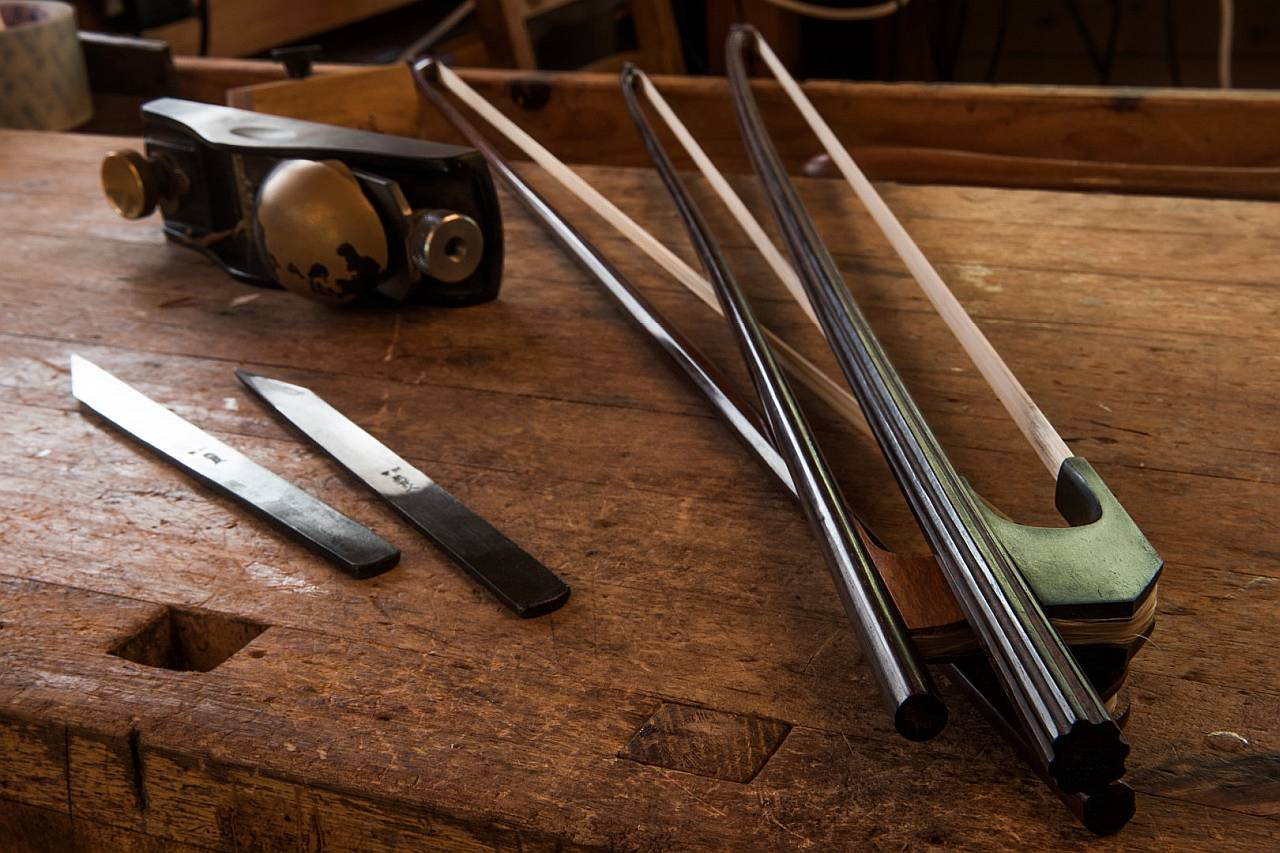
4. Hair tightening
The early violin bows had a detachable frog (a clip-in frog) before the screw mechanism was invented. Later, the bows would incorporate tightening with the screw but the hair would still be loose at the frog – meaning not held tightly by the ferrule.
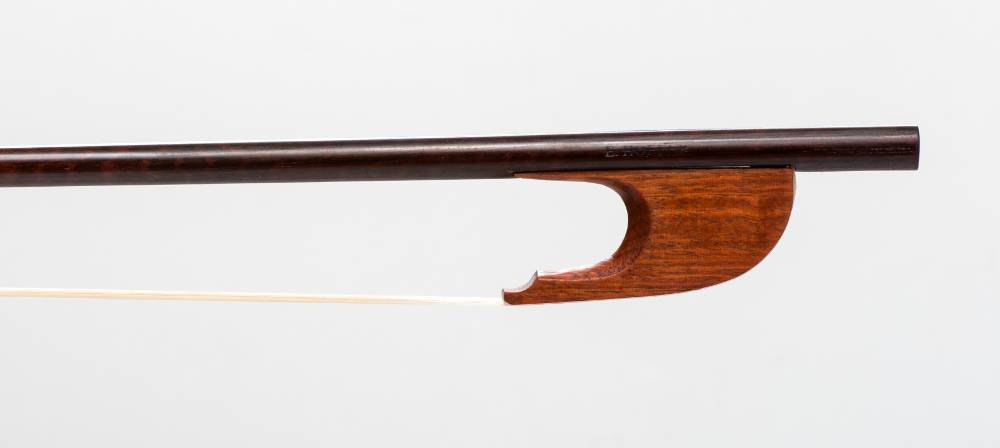
The screw mechanism and the ferrule are standards for the modern bow.
5. Winding and leather
On the Baroque bows, there was no winding, leather, or any kind of wrapping, which helps have a good grip on the modern bow.
6. Hair
A modern bow has up to 200 strands of horsehair. The baroque bow has less hair than that.
7. Tip
The Baroque bow’s swan-like and elongated tip has a flat, pointing ending. Have a closer look at it, do you see how close the hair is to the stick near the tip?
In the modern bow, the wood at the tip and the hair are at the right angle, and there’s more wood in this part of the bow.
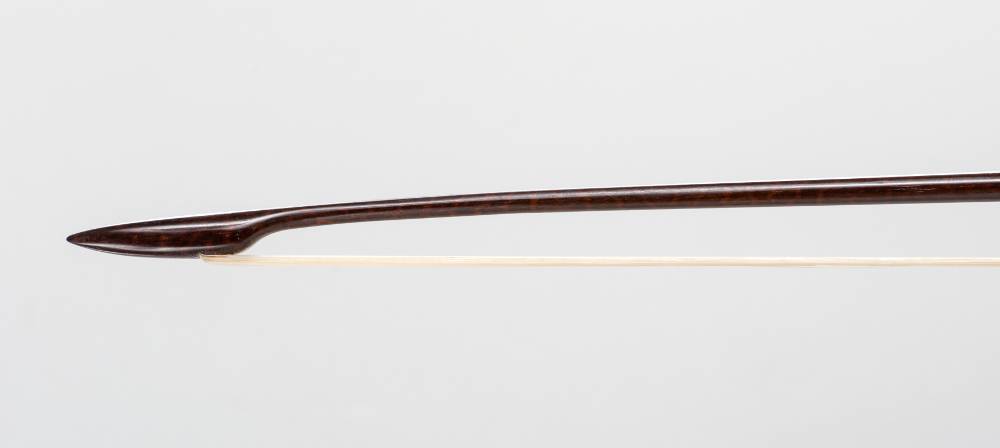
Below, you can see a close-up of three modern bow tips and four examples with Baroque-style tips.
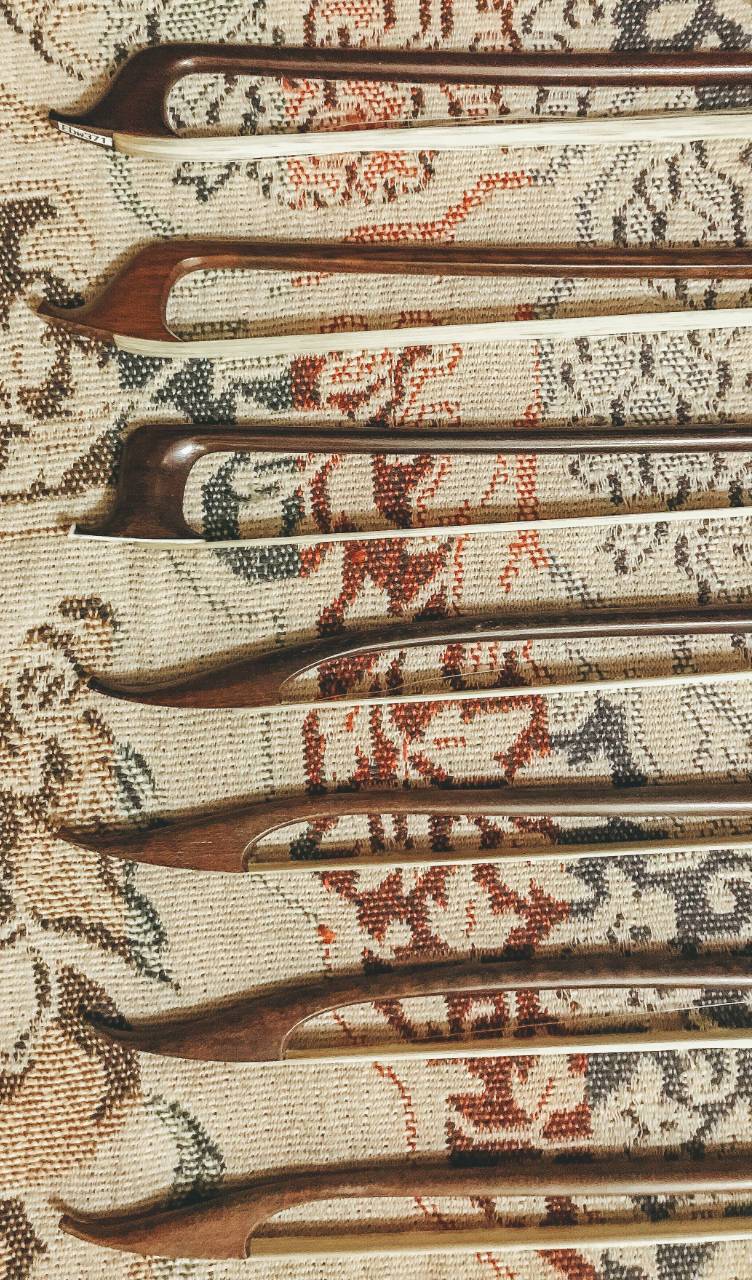
8. Wood
Snakewood and ironwood were used to produce Baroque bow sticks. Bow sticks for modern bows are made from Pernambuco, brazilwood, snakewood, fiberglass, carbon fiber, and also can be hybrid.
9. Bow hold
In the Baroque period, the bow was held above the frog, so the player would have only the stick in their hand. Currently, the most frequently used bow hold is at the frog – see the picture.
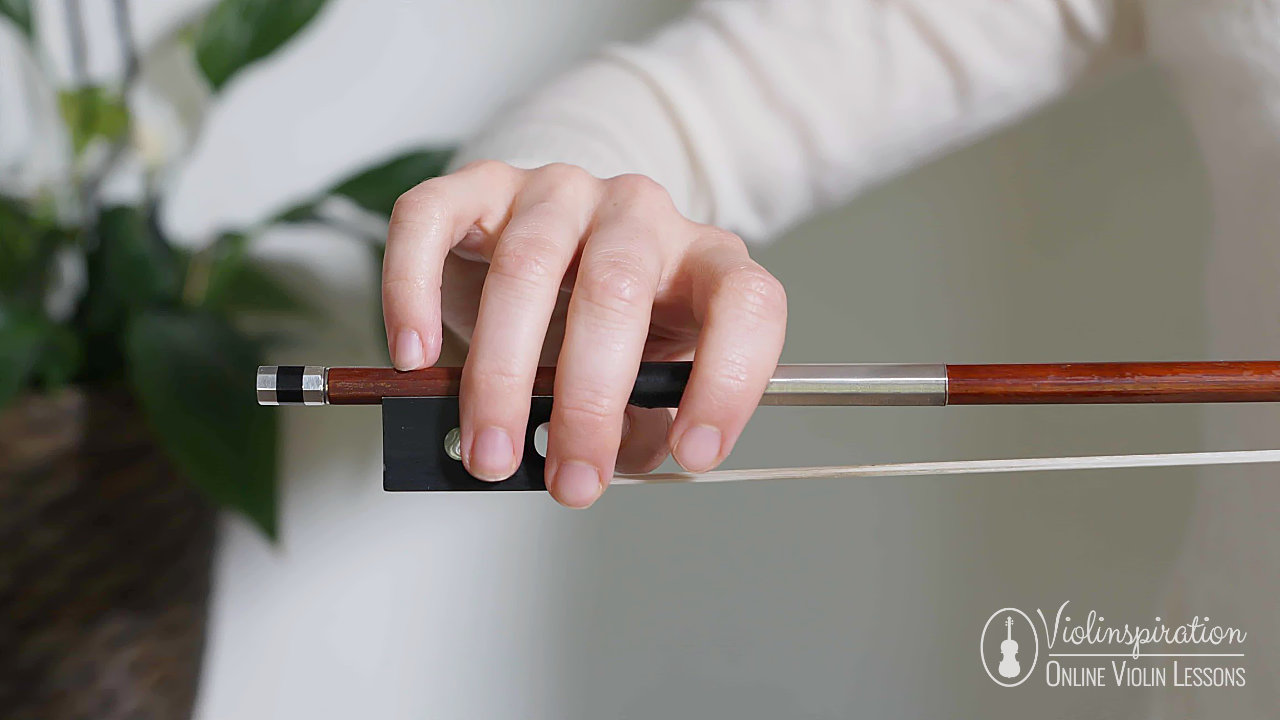
Also, the violin was held differently. There was no chinrest nor shoulder rest, so the violin was held against the player’s chest. Because of that, the whole right arm was placed lower than nowadays.
10. Sound
The baroque bow was heavier at the frog and much lighter at the tip, so it produces a different volume than the modern bow, especially close to the tip where it diminishes. It makes it perfect for playing very fast passages and accenting strong bits in the dance music with down bows. Also, such a bow makes playing string crossings and chords easier.
The modern bow has an even distribution of weight and tension throughout the bow, so it’s great for long strokes. It leaves it in the hands of the violinist to create the desired sound with all its aspects such as the dynamics.
Listen to the examples in the video below to find yourself how the sound differs between bows:
How the Baroque Violin Was Played
Now, when you know the specific characteristics of the Baroque bows, it’s worth taking a closer look at how the instrument was played during this period.
The typical Baroque violinist would hold the violin differently than we would today. The violin was pressed against a chest around the breastbone or sometimes put on the hip of the player.
The bow was held not at the lower end at the frog, but a few centimeters (inches) higher towards the tip. Usually, the violinist would use a lower 2/3 of the bow’s length and make many movements using the right-hand knuckles.
The rule of the down bow
Baroque music has the following rule: the first note of each bar and each stressed bit (so in a piece with 4/4 time signature it would be the first and the third beat) should be played down bow. This rule combined with the fact that the baroque bow is much heavier at the frog than at the tip resulted in a nice natural accent when making a down bow stroke.
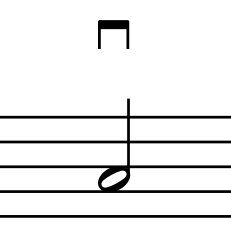
Baroque Bow in Use – Video Examples
Are you ready to listen to some examples of music played on Baroque instruments?
Summer from Vivaldi’s Four Seasons
First, have a listen to Summer from Vivaldi’s Four Seasons played on Baroque instruments:
Can you notice the differences in the bow itself and in the sound it makes compared to a similar performance on modern instruments? Feel free to add your observations in the comments below.
If by listening to this beautiful piece you got eager to learn an excerpt from Vivaldi’s Summer, make sure to check out my tutorials:
- Summer from Four Seasons by A. Vivaldi – Easy Version – best for beginners
- Summer, mvmt. 1: Allegro Non Molto by A. Vivaldi – intermediate version
Bach – Violin Sonata no. 1
Next, one of the most popular pieces composed by Bach: Violin Sonata no. 1 in G minor BWV 1001.
Modern Baroque composition: Come Bianca Luce
In the next composition, this time a modern piece for a period quartet by Massimo De Lillo, Come Bianca Luce, you can closely observe not only a Baroque violin bow but also period bows for viola and cello along with their specific way of holding.
Moving Away From the Baroque Bow to the Modern Style
The move towards the modern bow came as music styles began to change during the 18th century. Bows began to evolve to accommodate the longer notes that a violinist would play, particularly in opera houses across Europe.
Francois Tourte was one of the major innovators behind the modern bow. He created a number of transitional styles before creating the bow we recognize today. In comparison to the bow of the Baroque era, the most significant differences are the increased length, a shorter but thicker head, and the bow stick bending towards the hair.
The change wasn’t sudden. Between a typical Baroque bow and what we recall as a typical modern bow, there were many slight changes in between. To have a better overview, check the picture below. In this picture, you can see (from the right) four bows from the transitional period and three modern-style bows.
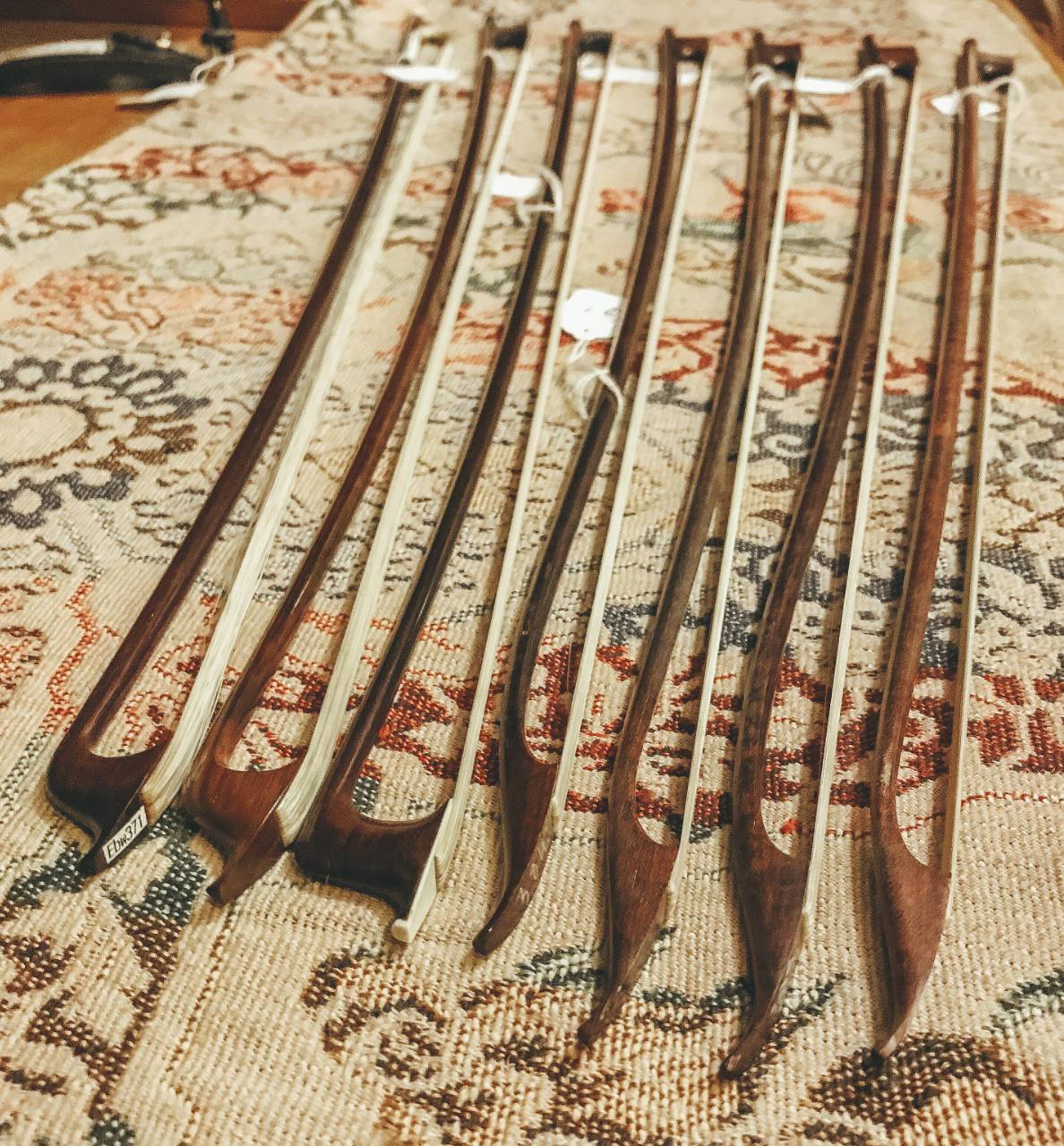
The Baroque Bow Today
Nowadays, by default violinists play the violin using a modern bow, also called the Tourte bow. Those who are dedicated to playing music as in the past (you may find it called a Historically Informed Performance) or are just interested in trying out other ways of playing the violin can still use Baroque bows.
For an authentic look and sound, bow makers create these contemporary Baroque-style bows using the original snakewood material and make them available for purchase in private shops just like Eitan Hoffer who allowed me to use his pictures in this post. You can also see many options in online music shops such as Thomann, or even Amazon.

FAQ about the Baroque Violin Bow
Now, let’s see what are the most frequently asked questions about the Baroque bows.
How is a Baroque bow different?
A Baroque violin bow is different from a modern bow in the following aspects: it is shorter ca. 10cm, weights ca. 4-10 g less, the stick is curved outwards or flat, has a clip-in frog, has no winding and less hair, the tip is flat and elongated.
Although there is no standard Baroque bow, its typical shape is distinctively different than the violin bow that we use today. Moreover, the Baroque bow produces a different sound due to the fact that the weight isn’t even across the bow. That’s one of the reasons why the music played on the modern instruments and with modern bows sounds different from music played as e.g. in the 17th century.
Are Baroque bows shorter?
Yes, Baroque bows are shorter than later transitional bows or modern bows. The difference can spread up to ca. 10 cm (ca. 4 in).
Which part of the Baroque bow has the least power?
The upper part of the bow has the least power when played due to the light weight of the tip and relatively heavy frog. The sound produced by a Baroque bow diminishes in the upper part (top 1/3 of the bow’s length) while making a down bow.
Conclusion
Looking at the bows from the Baroque period allows us to see the innovation behind the modern bows. You can see the development of the bow hold, shape, and even materials – from snakewood to the other materials that we use today such as carbon fiber. I hope that this knowledge will help you gain a better understanding of the violin’s bow and how to play it.
If you’re now curious to learn more about violin history, head on to this blog post: What Is the History of the Violin?
